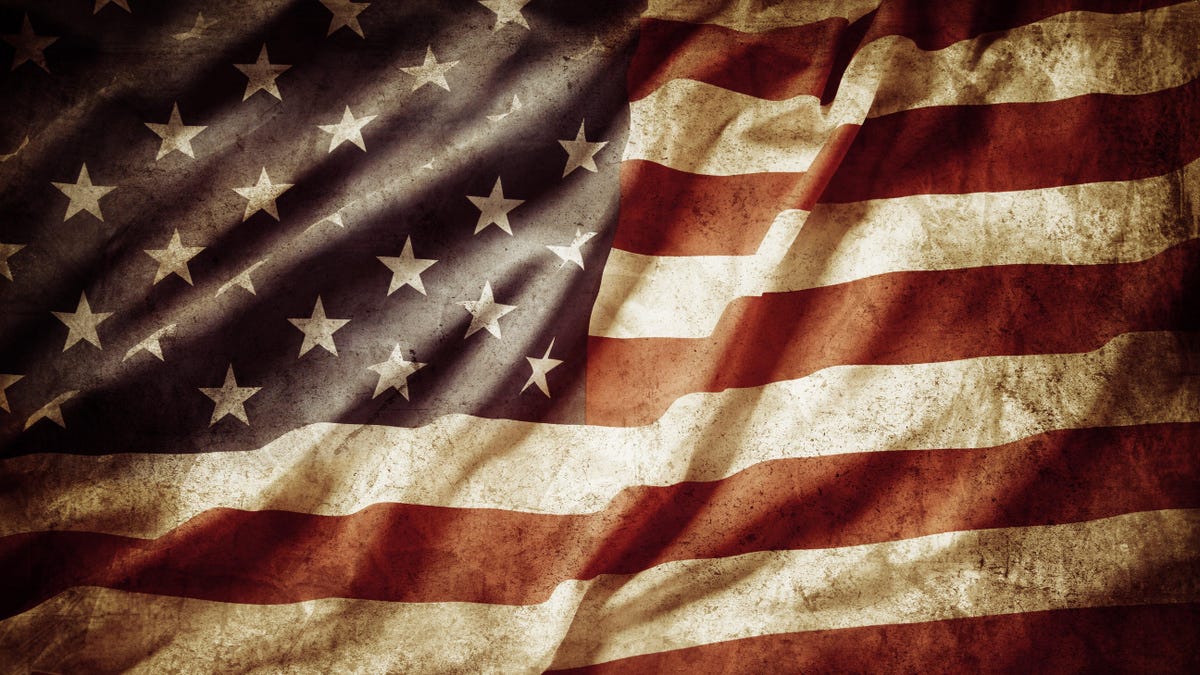9 Enduring Myths About American History (and What We Can Learn From Them)
What is the United States anyway? Sure, it’s a nation made up of 50 states that covers a good deal of a continent. But as my fifth grade social studies textbook would have you believe, it’s also made up...


Photo: STILLFX (Shutterstock)
What is the United States anyway? Sure, it’s a nation made up of 50 states that covers a good deal of a continent. But as my fifth grade social studies textbook would have you believe, it’s also made up of a righteous people with a common history and a shared set of beliefs and ideals that include truth, justice, and a better tomorrow. (Or, wait, maybe that’s Superman.)
Anyway, the thing is: Americans believe some really dumb crap about America and American history. Here are some of the biggest myths about our nation—and some thoughts as to what we can learn from them.
2 / 11
Christopher Columbus discovered America
Christopher Columbus discovered America

Photo: kyrien (Shutterstock)
Christopher Columbus didn’t discover shit. He wasn’t the first person—or even the first European—to come to North America. Vikings visited Canada 500 years before Columbus’ 1492 expedition and even established a small settlement, probably to repair their ships. There’s DNA evidence that indicates Polynesian people came to the Americas long before Columbus, too. But the people who actually discovered America were the Pre-Clovis people, who probably came via more than one route more that 15,000 years ago. What Columbus did do was open North America to European colonization.
The lesson: That so many people said “Columbus discovered America” when people clearly already lived here is evidence that Eurocentrism was stronger than basic logic, and large groups of people will believe the most insane shit imaginable as long as there’s racism and dehumanization at its core.
3 / 11
The United States was founded as a Christian nation
The United States was founded as a Christian nation

Photo: kharoll Mendoza (Shutterstock)
Surveys indicate that 65% of Americans think the Founding Fathers intended the U.S. to be a Christian nation. They didn’t. The leading figures in the formation of the United States had a variety of beliefs and didn’t wear their religions on their sleeves for the most part. But no matter what the Founding Fathers believed privately, the U.S. Constitution calls for a separation of church and state and makes no mention of Jesus. It’s clearly not a blueprint for a Christian nation.
It’s easy to see why people believe this myth. Some state constitutions drafted after the revolution required officeholder to uphold the Bible, and there have always been way more Christians than believers of any other religion in the US. Plus, it says “in God we trust” right on our money. Still, the idea that U.S. was founded as a Christian nation is spread largely by people with a political agenda, as it makes attempts to break down the wall between church and state easier.
The lesson: If an argument seems true and makes people feel good, they’ll ignore history to accept it every time.
4 / 11
The Wright Brothers invented the airplane
The Wright Brothers invented the airplane

Photo: Everett Collection (Shutterstock)
There’s a lot to unpack in the phrase “The Wright Brothers invented and flew the first airplane,” such as, what even is an airplane? And what does it mean to fly one?
In the years leading up to the Wright brothers’ historic (maybe) flight in 1903, so many inventors were working on heavier-than-air vehicles that the Aéro-Club de France established a set of conditions which defined whether a non-balloon, non-glider craft “flew.” Among them: The flight had to be controlled and manned, the craft had to take off under its own power, and—most importantly—the flight had to be demonstrated publicly before it “counted” so that everyone would know it followed all the rules.
Under these conditions, The Wright Brothers’ initial flights were not legitimate because there were no official witnesses to confirm that the plane took off under its own power, flew in a controlled manner, and otherwise behaved like a plane. Going by the Aéro-Club’s definition, the first heavier-than-air craft was flown by Alberto Santos-Dumont in 1906.
But even if you discount the “rules” of aviation created by the Aéro-Club de France—who are they to determine what’s an airplane, right?—you can make a strong case for Clément Ader as the inventor of the airplane. His Avion III flew over 90 meters (300 feet) in 1897 before crashing.
(For a deeper dive on the “first flight,” listen to this episode of the Our Fake History podcast.)
The lesson: A question like “who flew the first airplane” is more complicated than you might think.
5 / 11
Thomas Edison invented the lightbulb
Thomas Edison invented the lightbulb

Photo: Everett Collection (Shutterstock)
Like the Wright Brothers and the airplane, the invention of the lightbulb was ultimately the product of a lot of people working toward a similar goal. Here are only some of the milestones on the road to the lightbulb: Sir Humphrey Davy invented an electric light in 1809. There was no bulb—it was an arc of electricity—and it used too much power and was too bright to be useful. In 1840, British scientist Warren de la Rue invented a working lightbulb, but his design required platinum so it was not practical on a large scale. In 1850, Joseph Swan patented a lightbulb design without precious metal, but it required a lot of power and burned out very quickly. Edison’s innovation was improving the filament in Swan’s bulb. Edison’s lightbulb burned for a long time with less power and ultimately won the lightbulb wars when it was demonstrated in 1879.
The lesson: The fame and money often go to the person who does something best, not the person who does it first.
6 / 11
The 2020 presidential election was stolen
The 2020 presidential election was stolen

Photo: Matt Smith Photographer (Shutterstock)
More than a third of Americans believe that the 2020 election was not legitimate, even though there’s no evidence to suggest this is so. Since this is currently unfolding, it’s impossible to predict the outcome of such a large number of Americans questioning the foundation of our democracy, but if I had to guess, I’d say that nothing good will come of it. We’re in uncharted waters, and its terrifying.
The lesson: God only knows.
7 / 11
Betsy Ross sewed the first American flag
Betsy Ross sewed the first American flag

Illustration: Everett Collection (Shutterstock)
The idea that seamstress Betsy Ross sewed the first American flag comes from Ross’ grandson, William J. Canby. In 1870, Canby gave a speech in which he claimed his grandmother—who actually was a seamstress in Philadelphia during the Revolutionary War—was visited secretly by George Washington and asked to sew the first flag. Ross (the story goes) suggested a five-pointed star as opposed to a six-pointer in the new flag because it would be easier to cut. Washington agreed, and Ross sewed the first flag that she’d also helped design.
The problem with Canby’s story is that there’s no evidence it happened. It seems more like family lore than an account of a true event. We don’t actually know who designed the American flag. The rough idea comes from a resolution of the second continental congress, but we don’t know who decided on 13 stars and red and white stripes. Many historians think the final design was by Francis Hopkinson, a lesser known founding father who created a lot of seals for the fledgling United States. Hopkinson charged the U.S. government a cask of wine for the flag’s design, but he apparently never got paid. The Betsy Ross story caught on largely due to timing: We were approaching the centennial and Americana stories and flag-waving were in high demand.
The lesson: A messy historical truth cannot compete with an inspiring story.
8 / 11
Protestors spat on soldiers returning from Vietnam
Protestors spat on soldiers returning from Vietnam

Photo: Don Bilski (Shutterstock)
In a scene in 1982’s First Blood, Sylvester Stallone’s troubled vet John Rambo encapsulates a commonly held belief about veterans returning home from Vietnam. “I come back to the world and I see all those maggots at the airport, protesting me, spitting. Calling me baby killer and all kinds of vile crap! Who are they to protest me, huh?” Rambo asks.
The vet-being-spat-upon is a powerful image that perfectly illustrates the raw nerve of post-Vietnam America, but there’s little solid evidence that protestors (or anyone) actually spat on returning vets. Jerry Lembcke’s 1998 book The Spitting Image takes a deep dive into this myth and tries to come up with a real-world incident. His conclusion: “They spat on vets!” probably began as someone saying “they spat on vets metaphorically” and ultimately became a convenient way to discredit the anti-war movement.
The lesson: First Blood is a surprisingly good movie.
9 / 11
The two myths of Rosa Parks
The two myths of Rosa Parks

Photo: Gino Santa Maria (Shutterstock)
There are two competing versions of Rosa Parks’ famous bus ride. In one version of the story, Rosa Parks was a meek, old woman who was arrested after refusing to give up her seat on a bus to a white person because her feet hurt. In the other myth, Rosa Parks was basically a plant. She was chosen by the NAACP to be a test case to challenge segregation laws, and her arrest was planned as a way to kick off the Montgomery Bus Boycott.
The truth is somewhere in the middle. First, Parks wasn’t old and she wasn’t meek. She was 42 and a committed civil rights activist who worked for the NAACP. But her arrest on Dec. 1, 1955 wasn’t planned. Although the NAACP had been considering a response to Montgomery’s bus rules, they had to scramble to organize the boycott after Parks’ unplanned arrest. She wasn’t the legal test case, either. In March 1955, 15-year-old Claudette Colvin was arrested for refusing to give up her seat, and she was at the center of the legal case. But Civil Rights leaders saw Colvin as an inappropriate symbol for the movement. The symbolism was crucial, and the NAACP kept control of the narrative partially by allowing and encouraging Parks to be seen as a mild, “regular citizen,” as opposed to an activist.
The lesson: A public figure’s persona is rarely as complex as their actual identity.
10 / 11
Puritans came to America seeking religious freedom
Puritans came to America seeking religious freedom

Illustration: Morphart Creation (Shutterstock)
The Puritans were so named because they wanted to purify the Church of England by ridding it of Catholic practices and wealthy clergy. Once they got to the New World, it became clear that Puritans hated religious freedom.
The goal of the settlers, according to a Puritan minister in 1681, “was not Toleration, but [they] were professed enemies of it.” They exiled Roger Williams because he suggest tolerance of other religions and suggested Jesus wouldn’t want them to steal land from Native Americans. Puritans declared that “Familists, Antinomians, Anabaptists, and other enthusiasts shall have free liberty to keep away from us.” Puritan preachers like John Cotton preached that everyone should be forced to be Puritans.
And they really, really hated Quakers, taking the time to cut off their ears and tongues before hanging them. Then there’s the Puritan’s complete intolerance for everything about those “heathen” Native Americans, especially their religion. So yeah, not so in favor of freedom of religion.
The lesson: Christians claiming to be persecuted because other people won’t believe the same things they believe is nothing new.

 Troov
Troov 































